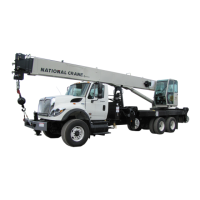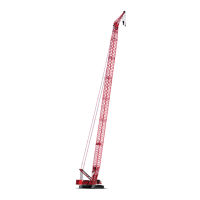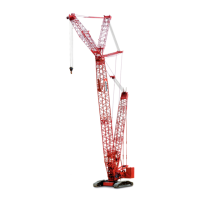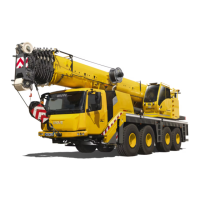National Crane 1-21-2019 Control # 104-07 1-23
1400A SERVICE MANUAL INTRODUCTION
• deterioration in areas subjected to rapid deterioration,
such as:
- sections in contact with saddles, equalizer sheaves,
or other sheaves where rope travel is limited.
- sections of wire rope at or near terminal ends where
corroded or broken wires may protrude.
- sections of wire rope in contact with stationary
surfaces where abrasion or chafing may take place
as a result of equipment vibration.
• damaged or wobbly boom extension and retraction
sheaves which can cause rapid deterioration of wire
rope.
• unusual cable sag/stretch. Be sure cables used in sets
all have an equal tension applied. Repeated need for
adjustment of an individual cable is evidence of cable
stretch and indicates the need for a more thorough
inspection to determine and correct the cause.
Wire Rope Replacement (All Wire Rope)
No precise rules can be applied to wire rope replacement
because of the variables involved. Determining the condition
of the wire rope depends largely upon the judgment of a
qualified person.
The information below is excerpted from a National
Consensus Standard as referenced by Federal Government
Agencies and Manitowoc CraneCARE recommendations to
help determine when wire rope needs to be replaced. Wire
rope shall be taken out of service when any of the following
conditions exist:
• In running ropes, six randomly distributed broken wires
in one lay or three broken wires in one strand in one lay
(Figure 1-5).
• Wear of one-third the original diameter of outside
individual wires.
• Kinking, crushing, bird caging, or any other damage
resulting in distortion of the rope structure.
• Evidence of heat damage.
• Reductions from nominal diameter of more than 5 %:
• In standing ropes, more than two broken wires in one lay
in sections beyond end connections or more than one
broken wire at an end connection.
• National recommends that for cable extended booms, a
single damaged wire rope assembly shall require
replacement of the complete set of extension cables.
• National recommends that boom extension cables be
replaced every seven (7) years.
Seizing Wire Rope
It is important to seize the ends of rotation resistant wire
ropes to prevent the displacement and unraveling of the
individual wires and strands at the ends. All preformed and
non-preformed styles of wire rope need to be seized prior to
cutting. Seizings must be placed on both sides of the point
where the wire rope is to be cut. The two methods for seizing
wire ropes are described below.
Method 1
Using a length of soft annealed wire, place one end in the
groove between two strands of the wire rope. Turn the long
end of the annealed wire at right angles to the wire and wrap
it tightly over the portion in the groove.
The two ends of the annealed wire should be twisted
together tightly. Cut off the excess wire and pound the twist
flat against the wire rope (Figure 1-6).
6
1
2
3
4
5
6
One Lay
FIGURE 1-5
One lay is parallel to the rope center-line and is the
distance for one strand to make a complete spiral
around the rope.
Fo
r
Reference
Only
